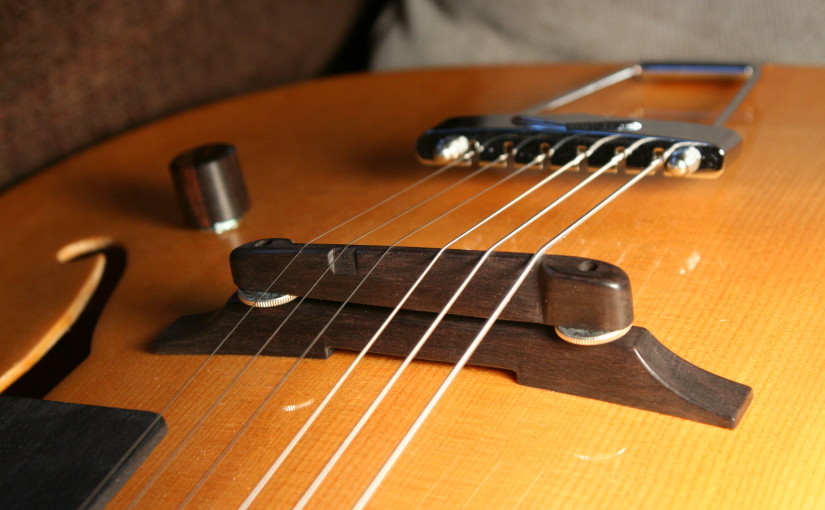Guitar setup is intended to maximize playability and assure accurate intonation. These are the steps to take to determine what to adjust, and whether there are underlying structural problems that must be addressed before correct setup can be accomplished.
Maximum playability means the lowest string action possible without unnecessary fret buzz. Start by checking neck relief. Fret any string at the first and fourteenth fret, and check in the middle to see how much space there is between the string and the frets, say, around the seventh fret. There should be a small amount of space – about 1/32″ or so. This space is necessary to prevent buzz because the string moves both side-to-side and up-and-down when it is struck. Assuming the neck has an adjustable truss rod, adjust the truss rod to give the correct relief.
Check a couple strings before adjusting the truss rod. Both E’s is a good start. Care must be taken in all steps of setup, especially with truss rod adjustment. Generally, you can assume that turning the adjustment nut clockwise will tighten the truss rod, adding pressure to create back-bow, reducing neck relief. This is not always the case, so proceed slowly. Make sure your wrench/allen key or other tool fits the rod nut tightly. Backing off a truss rod nut, turning counter-clockwise, is usually easier than tightening the rod. When backing off a rod, you can rely on string tension to bring the neck up, adding relief. When tightening the rod to reduce excess relief, it is best to use a clamp and block arrangement to bend the neck and then tighten the rod to hold the new position rather than relying on the rod alone to bring the neck back. Place a small block on the first and 14th frets, place a board across on top of the blocks and use a padded C-clamp to push the back of the neck upwards by springing the neck up between the two blocks. Go in very small increments and when you see the neck starting to bend, stop, tighten the truss rod a little, and take off the clamp. Check the relief again. If the truss rod nut ends up in a ‘neutral’ position, turn it one way or another to put it under a little tension, otherwise it may rattle.
Check string slots at the nut. Each string, when fretted at the fifth fret, should show a very small amount of space over the first fret. Slots that are too low will give string buzz on an open string; slots that are too high will make for painful fretting near the nut. Slots that are too low can be filled in with powdered bone and Krazy glue, and re-slotted. Get a piece of cattle bone, sand it to make dust and put some dust in the low slot. Add a drop of Krazy glue and let it set. File the slot. Slots that are too high can be filed. You need a couple nut files to do this, but not a whole array of them. Two files, one of about 0.013″ and one of about 0.028″ should work – use them side-to-side as needed to make slots wider than their designated size.
Set the action by checking the string height above the twelfth fret. The open string on the bass side should show around 0.110″ (a little less than 1/8″) space between the string and the 12th fret, and the treble should show a little less – say around 0.090″. Corrections are made by lowering or raising the saddle. Raise of lower the saddle by twice the amount that you want to correct at the twelfth fret. Bone saddles are adjusted by filing to lower, or making a new saddle if they need raising.
Check the intonation. A string produces a certain pitch at any given length and tension. Holding that same tension, cutting the length of the string in half produces the octave. The twelfth fret is theoretically at the halfway point between the nut and the saddle, and therefore produces the octave of the open string. However, when the string is fretted along its length it is stretched a small amount, and this increases the tension, raising the pitch a small amount. Intonation is about putting the saddle in the correct position such that each string, when fretted at the 12th fret, produces the octave. In practice, the distance from the nut to the saddle will be slightly longer than the stated scale length, because of compensation for stretch. Bass strings are more affected by string stretching than trebles, and steel strings are much more affected than nylon strings. Guitars with moveable bridges or individually adjustable saddles are much easier to intonate than flat tops with bone saddles set in wooden bridges. Using an accurate tuner, check each string, and move the saddle so the open string and the octave are both in tune. On flat tops, adjustments are limited to the width of the saddle, and are made by filing either the front or the back of the saddle for each string as needed. Because bass strings are more affect by stretching than trebles, you see the characteristic slanted saddle position.
At this point the guitar should play in tune, smoothly and without buzz. If buzz is apparent, the frets may need to be leveled. Loose frets that don’t stay down, and heavily worn frets, will create buzz problems for the neighboring frets. This and other problems will be addressed in a future blog.
